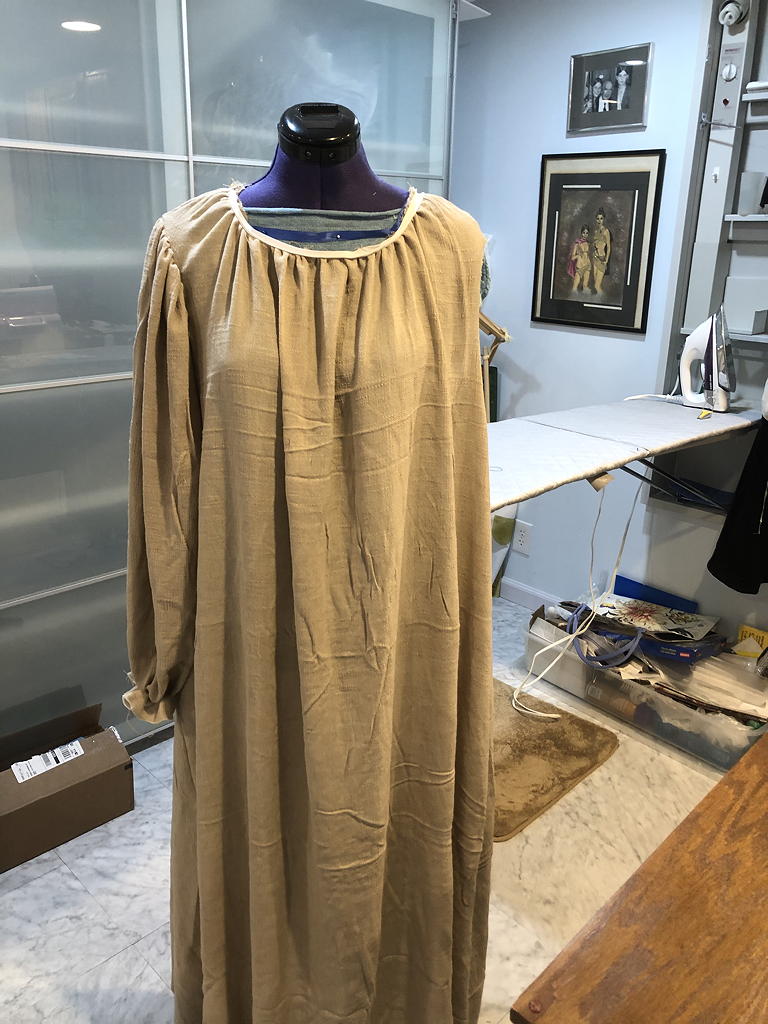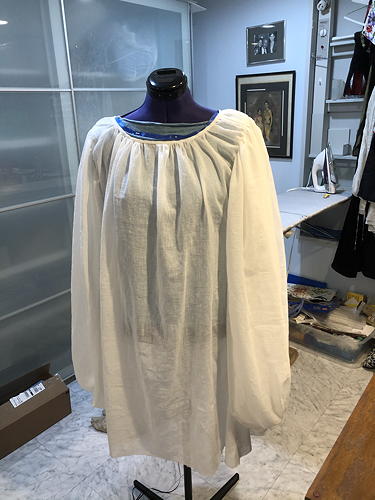No one would expect a simple chemise to take nearly two weeks to sew. I certainly didn’t. However, here we are and it’s not quite done yet.
One of the reasons I am doing this is to get some experience in pattern drafting; a skill I had never done before. I hauled out my pattern drafting book and my pristine roll of pattern drafting paper, lined up pens and rulers, and French curves and got to work. There are different amounts of ‘puffiness’ on the neckline and on the shoulder, so I could not use a ‘raglan’ construction.

Eight drafts later, I had something that looked like a pattern! It even had a very interesting shoulder that added the right amount of gathering without adding any extra material into the armscye seam.

In a burst of pride and enthusiasm, I showed it to a few people, one of whom is a judge (though I am not sure if they are a judge of my project or not). I was told it was wrong. That I should not do modern patterning. I should just do squares and gussets. Sigh. That kinda killed my enthusiasm for a few days. However, just for my own satisfaction, I put together a partial mock-up of the pattern just to see how it would have worked. The shoulders are a trifle wide, but that would have been an easy fix. I like the way the gathers lay on the neckline.

So then, after a few days of sulking, er.. doing other projects around the house (we are remodeling the laundry room) I redid the whole thing in the real fabric with more ‘period’ techniques. To get an even gather all around the neckline, as the illustration I am using shows, the shoulders have to be gathered on both sides.

Since the linen gauze fabric is so much finer than the mock-up fabric, I also made the sleeves wider and longer. Sewing two gathered pieces together is best done with a stabilizer strip. I cut a one inch wide piece of the gauze and pinned it to the gathered shoulder edge to the correct length. It was then sewn down and the pins removed before insetting the sleeve.

The sleeve is a rectangle of fabric 56″ wide and about 31 inches long. There is a 4″ gusset on the bottom to allow proper fit. The side seams have 28″ gores.

The wrists are gathered and will have a band sewn on because there is way too much fabric to have a frill as shown in the illustration with the sleeve fabric.

I bought navy blue silk ribbon for the edge detail but it was not dark enough. I have re-ordered black ribbon. When it arrives, I will add the edge detail.

In other good news, I have received the contrast fabric for the sleeves. It is wine red wool and it has the same weight and hand as the body fabric. I am going to have to get some better lighting to take the pictures. The blue just washes out completely under my sewing room lights.

We start working on the hat on Sunday.


Everything about your outfit is so lovely and I love how you’ve matched the visual details and the impressions of textures in the artwork.
And now I need to re-gather the back neckline. We tried it on under the bodice mockup over the weekend and it needs taking in in the back. On the the other hand, the bodice mockup is coming along and we made some decisions on the hat fabric and structure.
The hat will be three layers – a wool cap on the back for the hair, a shiny veil in silk, and the transparent cap in silk organza over all.
and why don’t I see a log-in button or the message controls any more? Sigh.
I didn’t say it was wrong. I tried to point out it was overly complicated for the extant samples and patterns taken from extant samples that I have seen. 🙂 It is looking nice and floofy, though! Great fabric choice.
Is it just me or was y experience of mumblty-mumble years back correct that the secret to puffy sleeve tops was big Raglan sleeves to reduce the amount of fabric at the neckline and tight overdress armscys and segmented sleeves? It worked on 1370s Italian…
Is it just me or was y experience of mumblty-mumble years back correct that the secret to puffy sleeve tops was big Raglan sleeves to reduce the amount of fabric at the neckline and tight overdress armscys and segmented sleeves? It worked on 1370s Italian…
Are you familiar with Cut My Cote? I’m wondering if the construction of the chemise in your image would be similar to the 17th century Italian shirt on page 13 of the book. That uses basic rectangles as well. Just a thought for any future experiments!